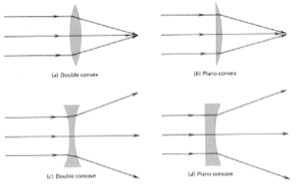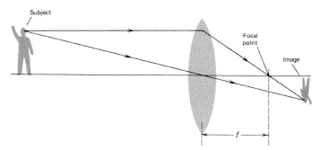Lenses
There are two types of lenses that we will deal with:
Convex lenses
Convex lenses are always fatter in the middle.
Convex lenses tend to bend light rays inward.
Images formed by convex lenses are upside-down.
Concave lenses
Concave lenses are always thinner in the middle
Concave lenses tend to bend light rays outward
Convex and concave lenses can come in different shapes, but convex ones are always fatter in the middle, and tend to bend (refract) light rays inward; while concave lenses will always be thinner in the middle and tend to bend light rays outward.
Image Formation:
Photons travel out in all directions from a point source, which is a very small light source (think, for instance, of a tiny light bulb). The paths the the photons take are the rays. If some of these rays are made to converge (say, with a convex lens), and come ‘into focus’, then an image of the point source will be formed.
Extended objects:
To figure out how an image of an extended object (like a tree, or car, or whatever) is formed, just pretend that every tiny spot on the object is a point source. If you repeat this process for every point on the object, then you’ll get the image of the entire object. Notice that there is one ray that passes through the center of the lens and doesn’t get bent. This exact center of the lens has a special name, the nodal point.
08. Lenses and images
1:33 PM
Lenses are devices that refract light.




